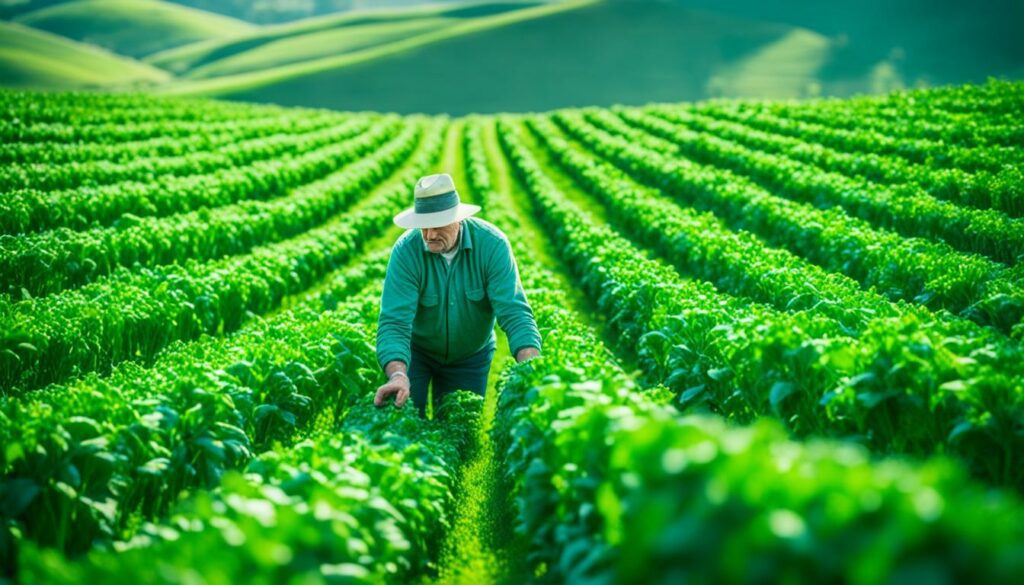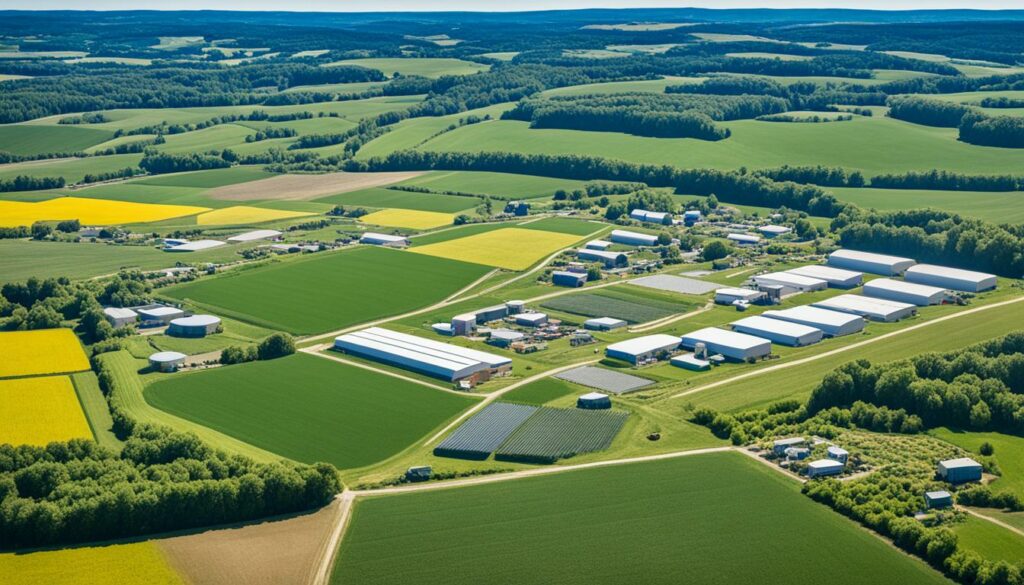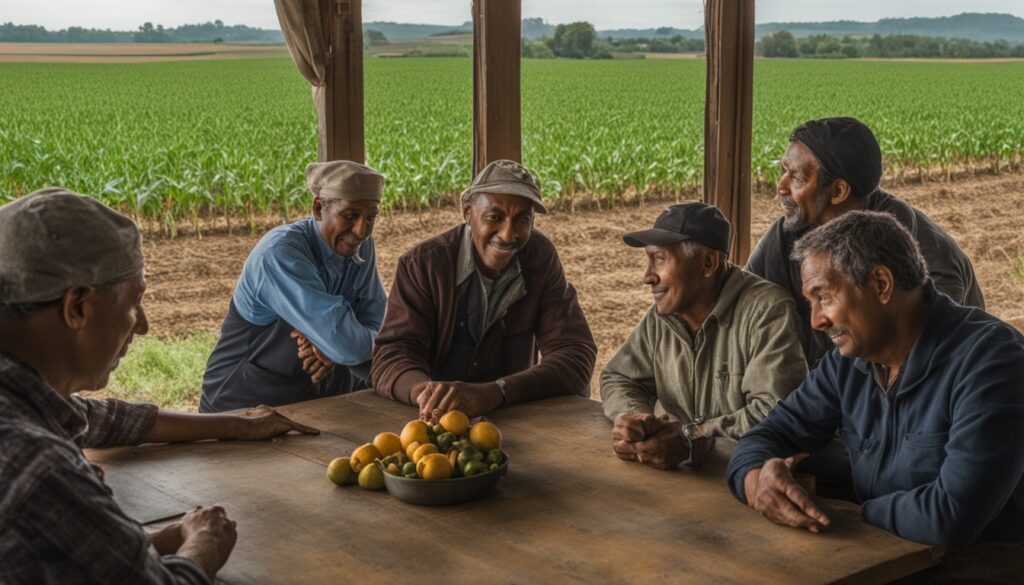Menu

Experienced loan officers in the small farm sector have over 159 years of experience. They help new farmers get the funds they need. I aim to highlight the crucial steps in starting a farm. This includes the important planning and the resources available.
Getting funds for small farms is challenging but rewarding. It’s important for both new and experienced farmers to create a solid business plan. They should look into various funding options and seek technical help. My advice covers everything from planning to disaster aids. It helps you find many funding sources and resources for different farming needs.
The USDA offers grants and loans specifically for new farmers. There’s also support for green energy use. Additionally, groups like the National Sustainable Agriculture Information Service and Farm Credit offer financial help and planning aids. Knowing about these options is crucial for a farm’s growth and success.
Starting a small farm? Knowing how to get funds is key. You can get money from many places, which can help start and grow your farm. We’ll look into what funding is and why it’s important for small farms.
Small farm funding means getting help to grow a small farm. It includes grants, loans, and subsidies. These help farmers start, expand, or keep their farms going. For example, the Value-Added Producer Grants and Beginning Farmers and Ranchers Loans from the USDA’s show what’s available for new farmers.
To fund a farm well, certain things are needed. Capital, credit, and investment are vital. An example of financial support for beginners is the USDA’s Microloan Program. This offers loans up to $50,000. The Sustainable Agriculture Research and Education Programs (SARE) also help out.
Knowing where to look for farm funds is important. Money can come from federal and state programmes, farm banks, and lenders. The USDA supports many funding schemes, like the Farm to School Grants. It tries to help local food growth. The Farmer Veteran Coalition and ATTRA also play a big part. They give advice and support for small farmers.
Creating a strong farm business plan is key to building a successful farm. It is more than just a piece of paper. Think of it as the blueprint for your farm’s operations, budget, and how you’ll sell your products. By putting in the effort to create a detailed plan, you’re setting up your farm for success.
First, you need to clearly define what you want to achieve. This is your farm’s mission statement. It shows your farm’s values and its purpose. Next, learn about your customers, what they want, how much they are willing to pay, and how many you can expect to buy from you. This is called market research. Use this information to shape your business plan.
Then, not forget about how your farm will actually work day-to-day. You need to lay out how it will be managed and what’s needed for it to operate well. This is your operational plan. After that, think about how much money your farm will need and how it will make money. Use financial planning tools to help, like the USDA’s FSA-2037 template. Also, think about what your farm is really good at and where it could improve. This is a SWOT analysis.
Finally, you need to decide how you will sell your products and get your name out there. This part is your marketing strategy. It should show how your farm will stand out in the market.
A well-thought-out business plan is essential for any farm, big or small. It’s vital if you need a loan because banks and other lenders will want to see it. The USDA offers help with business planning. They make sure your plan is strong and meets financial standards.
There are many types of business plans, from detailed reports to simple outlines. All aim to show your farm’s operations and its goals.
There are several key steps to creating your farm business plan:
There are plenty of resources out there to help you with your farm business plan:
If you’re a historically underserved farmer, a woman, or you own heirs’ property, extra support may be available. The NRCS staff at USDA Service Centers can help with conservation plans to improve your land’s health.
Agricultural grant funding is key for small farms and allows for farm growth. Many grants are out there, helping reduce financial challenges for small farms. The USDA supports projects for both new and skilled farmers, ensuring many areas of growth are backed.
New farmers get around 30% of small farm funding. There are also special grants for veterans, helping them start farming.
A big ratio favours small and family farms over large ones, focused on grassroots growth. For example, SARE Grants give up to $29,000 for sustainable farming over traditional methods.

The USDA Risk Management Agency helps agricultural producers handle risk. Seventeen private-sector companies work together to ensure stable farm operations.
The Renewable Energy Grants fund projects from $2,500 to $1 million, big on sustainable energy in farming. This shows the growing interest in green energy.
There’s a focus on specialty crops, too. Funds from the Specialty Crop Block Grant can boost the market presence of items like fruits, veggies, and tree nuts.
There are grants like the Farmers Market Promotion Program, which helps with $50,000 to $500,000. It’s for making local markets thrive. Then, there are the Value-Added Producer Grants up to $250,000. They help farmers enhance their products and grow their market.
Last but not least, many groups and websites support small farming. Over hundreds of organisations and websites are ready to help. By exploring these options, small farm owners can build successful and resilient businesses.
Getting stable funding is key for your farm’s success. The government offers help through state agricultural programmes and many other financial aids. Knowing how to get this support is very important for all farmers, new or experienced.
The USDA is a big giver in government farm funding. It has given out over 8,400 microloans since 2013. Seventy percent of these helped new farmers. Also, the USDA granted nearly $10 million to Farm to School programs to buy local produce.
These federal aids cover a lot of farming needs. There are grants like the Farmers Market Promotion that can give up to $500,000. The Value-Added Producer Grant helps with up to $250,000 to improve your farm.
State agricultural programmes help meet local farm needs. States differ in who and how much they help. For instance, New York gives out grants for its agricultural companies. Western SARE also offers money, and its deadline is October 25, 2023.
Some programs focus on specific groups, like minority or rural women farmers. The Sky High Farm Grants accept applications till April 22, 2024. Texas Woman’s University helps rural businesses starting from May 28 to July 5, 2024.
Knowing how to apply for farm funding is crucial. The USDA is working to make applying easier, especially for smaller farms.
To apply, you often need to show how you’re helping the environment or using new tech. A strong business plan and being open to working with others can boost your chances. Each state has its own requirements, yet they all look for clear goals that match their aims.
| Funding Program | Grant Amount | Application Deadline |
|---|---|---|
| Farmers Market Promotion Program | $50,000 – $500,000 | Varies Annually |
| Value-Added Producer Grant | Up to $75,000 (planning); Up to $250,000 (working capital) | Typically Annual Deadlines |
| Western SARE Farmer/Rancher Grant | Up to $25,000 ($29,000 for collaborations) | October 25, 2023 |
| Sky High Farm Grants | Varies | April 22, 2024 |
| Texas Rural Woman Grant | Varies | May 28 – July 5, 2024 |
Understanding the procedures of both federal and state programs is vital. With this knowledge, farmers can better their odds of securing funding. This support is crucial for their farms’ growth and success.
Small farm loans help both new and experienced farmers get the money they need. They are perfect for those starting out with little cash or wanting to grow. We will look at the different loans, how to get them, and the easy steps to follow.

Different loans suit various farming needs. The USDA’s FSA Microloan Program is great for small amounts up to $50,000. It requires less to qualify and has low interest rates. For new farmers, FSA direct loans up to $300,000 are available. These loans can cover start-ups, buying equipment, improving your land, and marketing. It’s important to look at all your options to find what fits your goals best.
To get a farm loan, a few things are crucial. For example, the FSA’s Beginning Farmer and Rancher Program needs you to be farming for less than 10 years. You also must be actively working on the farm. Plus, you shouldn’t own land over 30% larger than the county’s average. Meeting these rules and having a good business plan will help you get a loan.
The process of applying for a farm loan might seem tricky, but we can make it simpler. First, get all your documents ready, like your business plan, finances, and farming history. Then, apply through the right governmental or farming credit offices. Remember, local banks are also great for young farmers, as they often support smaller loans and build important relationships. If one place doesn’t fund you, there are other options to try.
Being smart with your money is key. Don’t spend all your cash on land; keep some for improving your farm. Using farm loans wisely and following good advice can help ensure a successful farming career.
Rural development finance offers a big hand in boosting farming in the countryside. It provides loans, grants, and loan guarantees, designed especially for rural farms. With these, farmers can start various projects like adding renewable energy systems or making new products. These efforts boost the economy of rural spots.
Knowing the deadlines to apply for funds is vital. For example, the deadline for the Socially-Disadvantaged Groups Grant is 3 June 2024. The WORC Initiative deadline is 20 June 2024. Also, mark 30 June 2024 for the Rural Microentrepreneur Assistance Program and the REDLG. Being ahead and informed improves your chance of getting help for your projects.
Here are key programs and their deadlines to watch for:
| Programme | Application Deadline |
|---|---|
| Socially-Disadvantaged Groups Grant | 3 June 2024 |
| WORC Initiative | 20 June 2024 |
| REDLG | 30 June 2024 |
| Rural Microentrepreneur Assistance Program | 30 June 2024 |
| USDA Intermediary Relending Program | 1 July 2024 |
| Community Development Block Grant Program | 15 July 2024 |
Ongoing programs like the Beginning Farmers and Ranchers Loan Program and the Microloan Programs are always available. By relying on the USDA and other sources, one can find loans and grants for agribusiness growth. There are many options including the Business & Industry Loan Guarantees and Economic Development Assistance Programs.
Getting rural financial aid can change the game for small farms, helping them use new ideas and run better. By exploring these finance options, you make sure your farm stands out and goes the distance.
Subsidies are key for many small farmers around the world. Knowing how to best use them can cut costs and boost the farm’s success. This dive into subsidies will guide farmers on maximising their benefits.

Farm subsidies aim to help farmers in many ways. They keep incomes steady, boost farm output, and help when market prices shift. Over 500 million small farms benefit, especially in Asia and Sub-Saharan Africa. There, 90% of farmers rely on these supports. Globally, governments put up to $700 billion a year into these schemes.
Farmers must meet certain criteria to get these subsidies. They often have to farm sustainably and help ensure there’s enough food. Sometimes, they must join specific farming projects. To show how this helps, back in 2005, nearly 60% of Malawi’s farming budget went to help buy fertiliser, lowering costs for small farmers.
Similar, efforts in Burkina Faso and Ghana have tackled hunger and boosted planting trees. These case studies show smallholder subsidies can make a big difference.
To get subsidies, farmers need to go through a step-by-step application process. Here’s what they usually need to do:
To wrap up, fully using farm subsidies means knowing what’s on offer, fitting the criteria, and applying well. This three-step approach can help small farmers boost their earnings and farm smarter.
Rural enterprise grants help small agricultural ventures in the United States. They offer needed funds and help farms grow and innovate. By using the correct strategies, getting these grants becomes much more likely.
Rural grants aim to help farmers and rural businesses grow. Since 2013, the USDA has granted over 8,400 microloans, with most to new farmers. They’ve also invested nearly $10 million in Farm to School grants, showing a strong local agriculture support commitment.
This support includes things like Market News to help with smart business decisions. These efforts make applying for rural grants more successful.
Rural grants have had big success stories. The NRCS’s High Tunnel Initiative has improved farming for over 10,000 people since 2010. The AFRI supports small farmers with new tech and management tactics, showing how efforts in sustainability and innovation lead to success.
For rural grants, a clear and detailed proposal is key. Make sure to:
Following these steps can greatly increase your chances of getting a rural grant. This helps your business grow sustainably.
It’s vital for farmers to know about and use financial help. This aid makes farming more stable and lets it grow. Many programmes are there to help farmers across all steps of their work.

Money help for farming includes many options like grants and loans. For example, the ARC-CO and PLC give farmers money when they need it most. Also, the CRP gives farmers long-term deals for peace of mind.
In financial need, loans are a farmer’s best friend. There’s the Direct Farm Ownership Loans that need no past ownership. Then, microloans help new or small farmers. For big financial bumps, there’s the Guaranteed Farm Ownership Loan and Guaranteed Operating Loan.
Important agencies like the USDA have programmes for farmers’ hard times, like the Emergency Relief Program. The Livestock Indemnity Program helps by giving 75% of an animal’s value when it dies.
In California, the California Department of Food and Agriculture (CDFA) also steps in. They focus on helping special farmers with grants for environmentally friendly projects. These include the Alternative Manure Management Program (AMMP) and the Dairy Digester Research and Development Program.
Getting help from these big organisations needs to follow their application steps. For example, if your crops fail, there’s a special form for that. Marketing Assistance Loans are easy to get and really help at tough times.
California farmers can apply for special programmes too. For example, the Healthy Soils Program helps make the land healthier. And the State Water Efficiency and Enhancement Program (SWEEP) helps save water and money.
| Program | Description |
|---|---|
| ARC-CO | Issues payments when actual county crop revenue is less than the guarantee. |
| PLC | Provides payments when the effective price is less than the reference price for covered commodities. |
| CRP | Long-term contracts of 10-15 years for conservation purposes. |
| Direct Farm Ownership Loans | Offer 100% financing with no previous ownership requirements. |
| Microloans | Focus on small-scale, beginning farmers, niche, and non-traditional operations. |
| Guaranteed Farm Ownership Loan | Maximum amount is $1,825,000 for FY 2022. |
| Guaranteed Operating Loan | Maximum amount is $1,825,000 for FY 2022. |
| Livestock Indemnity Program | Payments are equal to 75% of the average fair market value of livestock. |
By using these support options, farmers can overcome challenges and make their farms better. This support also helps them keep farming for years to come.
Getting money for a small farm is hard but doable. This financing guide for small farms will make things simpler. It talks about farm finance steps and ways to get the money you need.
The USDA has lots of loans for new farmers. They can help you get started by giving loans to buy land. New farmers can buy land from the FSA first, before it goes to others. Notably, the USDA doesn’t give grants to buy land, but they do have small grants to help with special things like protecting the land.
My tip is to use tools from the FSA. They have online help and factsheets that are very useful. Using USDA loans can help cover major costs. This includes buying land, farm buildings, seeds, animals, and tools.
The USDA also helps farmers in need. This includes those who are socially disadvantaged, have few resources, or are veterans. They have a loan programme to help farmers protect the land. This is great for those trying to farm in a healthy, earth-friendly way.
Don’t forget about the SBA, which helps all kinds of small businesses, including farms. They offer more ways to get money. Adding SBA loans to USDA loans can really boost your farm’s finances.
Here’s a list of some loan types to help small farms:
| Loan Type | Purpose | Target Group |
|---|---|---|
| USDA Direct Loans | Purchase land, buy equipment, cover normal operating expenses | Beginning farmers, socially disadvantaged farmers |
| FSA Microloans | Small farm needs, youth loans | Small and beginning farmers |
| Conservation Loans | Implement conservation practices | All farmers |
| SBA Loans | Additional business financing | Agricultural and food businesses |
This guide will show you how to find money for your farm. Use the information on farm finance steps here. It will help you get the money you need. Then, you can turn your focus to making your farm a success.
???? present an excellent chance for farmers to try new things. These new projects can make farms more sustainable and bring in more money. By getting creative, farmers can find different ways to earn. This builds up their farms to face challenges better.

Trying out new ways to make money on the farm has lots of advantages. It helps farmers rely less on just one way of making money. Let’s say they turn part of their land into a place where visitors can stay or enjoy food from the farm. This not only brings in new people but also creates a fresh income source.
It also helps farms meet what the market wants. This makes them more profitable over time. Having a variety of crops or animals can lead to better soil and farming practices that are good for the planet.
There are many great ideas that have worked, from making the farm produce more goods to using the latest eco-friendly methods. High tunnels are a good example of this. Since 2010, over 10,000 of these have been set up with help from the NRCS. They help farmers grow crops for longer parts of the year and get more harvests.
Another area that’s growing is farms working with schools. Since 2013, the USDA has put nearly $10 million into helping local farms supply food to schools. In one school year, schools spent around $355 million on local food. This is a big chance for farmers to sell their produce locally.
When you’re looking into getting a grant for new farm projects, it’s key to show how your idea fits the grant’s goals. Start by looking up the grants, like the ones the USDA offers. The microloan programme is great for new and diverse farming projects. It’s given over 8,400 small loans since it started in 2013.
An application that’s well-prepared shows what your project can do, how much it will cost, and what you expect to achieve. Make sure you have all the paperwork you need, like business plans and research. Showing that you use good farming practices can also help your application. This shows you’re serious and ready for the market.
| Programme | Objective | Investment |
|---|---|---|
| Microloans | Support for diverse operations | Over 8,400 loans since 2013 |
| Farm to School | Procurement from local sources | Nearly $10 million since 2013 |
| High Tunnels | Extend growing seasons | 10,000+ installations since 2010 |
Looking into diversification and going for the right grants can change your farm for the better. If you apply well, you could find new ways to make your farm grow.
Getting funding for your farm starts with careful application preparation for farming funds. I’ll show you what to include in your request to boost your chances.
First, gather all needed documents thoroughly. This key step in application preparation for farming funds involves getting financial statements, partnership deals, and company papers. You might need the FSA-2001 and AD-3030 for companies. Match your documents to what the funding program asks for.
Then, focus on proposal writing for farms. Your proposal should explain your farming goals and what you’ll achieve. Be as detailed as you can with the budget. A good proposal is short, often only two pages, and straight to the point. Attach all needed papers, like the project budget and your current financial details, to tell a full story.
To finish, steer clear of mistakes that could hurt your application. Don’t miss the deadline. Late applications are usually discarded. Also, hand in a tidy and complete application. Applying for the same funds from different places can also cause problems. By avoiding these errors, you’ll have a better shot at getting the funds you need for your farm.
| Loan Type | Maximum Amount |
|---|---|
| Farm Ownership or Operating Microloan | $50,000 |
| Direct FSA Farm Loans | Varies by applicant |
Engaging with farming communities deeply is crucial. It helps gather shared wisdom and opens doors for farmers. This way, they can enjoy better networking and more funding for their farms. Gathering together, farmers share priceless insights and support.

New York State is getting ready to help start-up and disadvantaged farmers. They plan to offer grants soon. Farmers need to keep up with this news. They can then make the most of these grant opportunities.
The USDA Farm Loan Programs and the NYSERDA Agriculture Energy Audit are big helps. They offer advice and services that can really aid farmers. By joining these community groups, farmers learn about loans and save on energy costs.
The USDA’s Grants, Loans, and Organic Certification Support benefit from community links too. Being part of these networks helps to figure out and access these programs. This makes getting important certifications and funds easier.
The NYS Grown & Certified Program is a great example of how coming together helps. It prepares farmers to sell to large buyers. Moreover, Cornell’s Baskets to Pallets Trainings teaches farmers how to sell in bulk. These are skills best taught in close farmer communities.
“The value of communal farming is huge. It turns single farmer struggles into group successes through resource sharing and joint funding.”
The New York State Farm to School, Food Export Northeast, and NYS Export Assistance show the strength of these farming ties. They push for local sales and exports. This opens up bigger markets for farmers.
For new farmers, these connections offer special aid. The USDA’s Microloan Program helped over 8,400 new farmers. Being part of a supportive farming community paid off for them.
Projects like Growing High Tunnel and GAP Certifications are benefits of farming communities. They help farmers extend their season and get important crop quality certifications.
The Rural Cooperative Development Grant Program is another example of community help. It supports rural businesses. It has created or saved more than 41,600 jobs. That’s key help for over 4,200 farmers.
Disaster relief is key for the farming industry when nature strikes. It helps keep farms running and protects farmers’ livelihoods.
Many programmes exist to help farmers in times of need. The LFP helps livestock producers who face grazing losses due to drought or fire. Then, the LIP aids in cases of livestock death from extreme weather or wild animal attacks. Lastly, the ELAP provides emergency aid for various losses.
It’s important to understand if you qualify for help. The NAP can assist crop producers if they bought NAP coverage and suffer losses. The Set-Aside Program lets farmers delay loan payments by a year. And there’s the TAP for tree replanting assistance.
The USDA offers help through tools like the Disaster Assistance Discovery Tool. You can also find guides in the FSA Fact Sheets and USDA Disaster Resource Center. These are for obtaining information about agricultural disaster support.
The Emergency Loan Program aids farmers to bounce back from disaster losses. The ECP helps fix farmland and save water during droughts.
To know more, here’s a table summarising essential disaster aid programmes:
| Program | Purpose | Eligibility |
|---|---|---|
| Livestock Forage Disaster Program (LFP) | Compensates for grazing losses due to drought or fire | Eligible livestock producers |
| Livestock Indemnity Program (LIP) | Benefits for livestock deaths exceeding normal mortality | Those affected by adverse weather |
| Emergency Assistance for Livestock, Honeybees, and Farm-Raised Fish (ELAP) | Emergency aid for various loss causes | Producers of certain livestock and bees |
| Emergency Livestock Relief Program (ELRP) | Compensates for feed costs due to drought or wildfire | Eligible livestock producers |
| Noninsured Disaster Assistance Program (NAP) | Compensates for low yields or prevented planting | Crop producers with NAP coverage |
| Tree Assistance Program (TAP) | Assists in replanting damaged trees | Orchardists and nursery tree growers |
Knowing about these resources helps farmers lessen the impact of disasters on their crops and animals.
Veteran farmers can get help through special schemes helping them move into farming. These schemes give money, teach skills, and provide learning materials. They ensure veterans are successful in farming. There’s a lot of funding opportunities for those interested in farming.

The USDA helps veterans with over 40 programmes in rural business. There’s also help for those farming in cities through the Urban Agriculture and Innovative Production Grants.
Alpha Omega Veterans Services and Source One Serenity show how impactful this funding can be. They boosted production and highlighted agriculture’s economic and health benefits for veterans.
Many veterans doing urban agriculture find help through programmes run by the USDA. The People’s Garden Initiative and Federal Advisory Committee for Urban Agriculture help a lot.
A program started in 2017 offers specialized training through grants to nonprofit groups. This means veterans get skills needed for farming.
The AgVets program is also key. It gives grants with help from experts in farming, government, and veterans’ affairs. This makes the support strong and effective.
To get this funding, veterans must meet certain rules and apply correctly. AgVets is for non-profits, but colleges can’t apply. They look for projects that teach practical farming skills.
Applicants must have clear plans to collect data and write progress reports. They need to report to USDA-NIFA every year. This shows the projects are working.
Annual meetings let project leaders and evaluators share what works. This helps projects use their money and knowledge well. It makes the farming community stronger.
We’ve explored many ways to get funding for small farms. This journey covered government grants and rural finance. I wanted to make sure you’re well-equipped to find the capital you need for your farm to grow. This will help your farm succeed in today’s changing agriculture world.
It’s key to know that most US farms are small, with many making under $10,000. Even though farming is moving towards bigger operations, small farms are still critical. They make up a big part of beef, grains, poultry, and hay production.
By learning about funding and overcoming financial challenges, small farms can keep going. They help a lot in local and international markets. So, making wise financial decisions is crucial. It will help you strengthen your farm’s economy and future.
Small farm funding helps start and grow farms. It includes grants, loans, and subsidies. This support is key for a farm’s economy and success.
Federal and state programmes, along with farm banks, are common sources. They offer grants and financial help. This support is vital for small farms to thrive and develop.
A good farm business plan is essential. It sets goals and helps in market research. It also outlines how the farm will operate and make money.
For a solid business plan, set clear goals and research the market well. Make detailed operational and financial plans. Look into resources like small farm handbooks for help.
Yes, special agricultural grant programmes exist. They target the needs of small and socially disadvantaged farmers. These grants cover various costs, from starting up to sustainable practices.
Governments offer grants, loans, and other support for small farms. These programs, like those from the USDA, help many groups, including women and minorities. They address a wide range of farming needs.
There are different small farm loans, including microloans. They’re for various needs and are available to beginning farmers. These loans come from public agencies and agricultural credit groups.
Rural development finance supports farms in rural areas. It provides loans, grants, and guarantees for projects. This includes helping with energy, new products, and aiding socially disadvantaged groups.
Farm subsidies are financial help for farmers. They can include income supplements and expense coverage. Knowing about these aids is crucial for small farm success.
Winning rural enterprise grants requires research and a strong proposal. Network within agriculture and clearly state your farm’s goals and vision in the application.
There are loans, grants, and planning help for farmers. These are available for different farming needs and scales. Support comes from various sources, online and in-person.
To get farm diversification grants, show how your farm will innovate. This could be through new processing methods or tourism. Make sure your application fits the grant’s requirements.
Getting ready for a funding application means getting all documents ready. Write a proposal that clearly shows your goals. Don’t forget to check deadlines and avoid leaving out important details.
Joining agricultural communities offers chances to network and learn. You can get tips on finance and resources. This can help your farm do better.
Disaster assistance is key for farmers dealing with natural events. Know the relief programmes and how to qualify. Being prepared can protect your farm and income.
Yes, veterans have special programmes to help them start farming. These programmes recognise their service. They offer tailored support for their farm businesses.